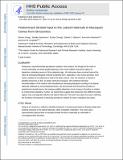| dc.contributor.author | Hong, Simon | |
| dc.contributor.author | Amemori, Satoko | |
| dc.contributor.author | Chung, Emily | |
| dc.contributor.author | Gibson, Daniel J. | |
| dc.contributor.author | Amemori, Ken-ichi | |
| dc.contributor.author | Graybiel, Ann M. | |
| dc.date.accessioned | 2020-05-08T14:25:00Z | |
| dc.date.available | 2020-05-08T14:25:00Z | |
| dc.date.issued | 2018-12 | |
| dc.date.submitted | 2018-09 | |
| dc.identifier.issn | 0960-9822 | |
| dc.identifier.uri | https://hdl.handle.net/1721.1/125131 | |
| dc.description.abstract | Striosomes, neurochemically specialized modules in the striatum, are thought to be nodes in circuits extending, via basal ganglia pathways, from mood-related neocortical regions to dopamine-containing neurons of the substantia nigra. Yet striosomes have remained beyond the reach of electrophysiological methods to identify them, especially in non-human primates. Such work is needed for translational as well as for basic science. Here we introduce a method to identify striosomes on-line in awake, behaving macaques. We combined electrical microstimulation of the striatum with simultaneous electrophysiological recording in the lateral habenula (LHb) followed by immunohistochemistry. We demonstrate that striosomes provide the predominant striatal input to the macaque pallido-habenular circuit, which is known to function in relation to reinforcement signaling. Further, our experiments suggest that striosomes from different striatal regions may convergently influence the lateral habenula. This work now opens the way to defining the functions of striosomes in behaving primates in relation to mood, motivation, and action. Keywords: basal ganglia; dopamine; motivation; non-human primate; mood; learning; microstimulation | en_US |
| dc.description.sponsorship | National Institutes of Health (U.S.) (Grant (R01 NS025529) | en_US |
| dc.description.sponsorship | CHDI Foundation (Grant A-5552) | en_US |
| dc.description.sponsorship | United States. Army Research Office (Grant W911NF-16-1-0474) | en_US |
| dc.language.iso | en | |
| dc.publisher | Elsevier BV | en_US |
| dc.relation.isversionof | http://dx.doi.org/10.1016/j.cub.2018.11.008 | en_US |
| dc.rights | Creative Commons Attribution-NonCommercial-NoDerivs License | en_US |
| dc.rights.uri | http://creativecommons.org/licenses/by-nc-nd/4.0/ | en_US |
| dc.source | PMC | en_US |
| dc.title | Predominant Striatal Input to the Lateral Habenula in Macaques Comes from Striosomes | en_US |
| dc.type | Article | en_US |
| dc.identifier.citation | Hong, Simon et al. "Predominant Striatal Input to the Lateral Habenula in Macaques Comes from Striosomes." Current biology 9, 1 (January 2019): 51-61 © 2018 Elsevier Ltd | en_US |
| dc.contributor.department | McGovern Institute for Brain Research at MIT | en_US |
| dc.contributor.department | Massachusetts Institute of Technology. Department of Brain and Cognitive Sciences | en_US |
| dc.relation.journal | Current Biology | en_US |
| dc.eprint.version | Author's final manuscript | en_US |
| dc.type.uri | http://purl.org/eprint/type/JournalArticle | en_US |
| eprint.status | http://purl.org/eprint/status/PeerReviewed | en_US |
| dc.date.updated | 2020-01-21T16:20:16Z | |
| dspace.date.submission | 2020-01-21T16:20:18Z | |
| mit.journal.volume | 29 | en_US |
| mit.journal.issue | 1 | en_US |
| mit.metadata.status | Complete | |
